Nicholas Carl, Brian Carter, Kathryn Tyson, Johanna Moore, Amin Soltani, Annika Ganzeveld, Peter Mills, and Andie Parry
The Iran Update provides insights into Iranian and Iranian-sponsored activities abroad that undermine regional stability and threaten US forces and interests. It also covers events and trends that affect the stability and decision-making of the Iranian regime. The Critical Threats Project (CTP) at the American Enterprise Institute and the Institute for the Study of War (ISW) provides these updates regularly based on regional events. For more on developments in Iran and the region, see our interactive map of Iran and the Middle East.
CTP and ISW have refocused the update to cover the Israel-Hamas war. The new sections address developments in the Gaza Strip, the West Bank, Lebanon, and Syria, as well as noteworthy activity from Iran’s Axis of Resistance. We do not report in detail on war crimes because these activities are well-covered in Western media and do not directly affect the military operations we are assessing and forecasting. We utterly condemn violations of the laws of armed conflict, Geneva Conventions, and humanity even though we do not describe them in these reports.
Key Takeaways:
- Iran and its so-called “Axis of Resistance” are pursuing a coordinated strategy to (1) deter Israel from trying to destroy Hamas in the Gaza Strip, (2) prevent Israel from destroying Hamas if deterrence fails, and (3) deter the United States from providing military support for Israel’s ground operation in the Gaza Strip.
- Hamas is conducting attacks targeting population centers and conducting an information operation to erode the will of Israel’s political establishment and public to launch and sustain a major ground operation into the Gaza Strip.
- Palestinian militias are trying to drive anti-Israel unrest in the West Bank to draw in IDF assets and resources and fix them there.
- The Axis of Resistance is harassing IDF forces with indirect and direct fire along the Israel-Lebanon border, which aims to draw IDF assets and resources toward northern Israel while setting conditions for successive campaigns into Israel.
- Iran and the Axis of Resistance are trying to demonstrate their capability and willingness to escalate against the United States and Israel from multiple fronts.
- Iranian and Axis of Resistance leaders will need to adjust their strategy and the subordinate campaigns if Israel launches a major ground operation into the Gaza Strip.
- Palestinian militias continued attacks at the usual rate from the Gaza Strip into Israel on October 25. Hamas fired two long-range rockets Haifa and Eilat as part of its effort to erode the Israeli political establishment’s will to support a ground operation into Gaza.
- West Bank residents demonstrated and took up arms against the IDF in response to calls from the Lions’ Den—an Iran-linked West Bank militia.
- The IDF conducted airstrikes against two Syrian military positions in southwestern Syria on October 24 and an airstrike on the Aleppo International Airport runway on October 25. Militants are likely to respond with indirect fire attacks, which is the consistent response pattern to Israeli airstrikes in Syria since the war began.
- The Islamic Resistance in Iraq claimed two attacks targeting US forces based at Abu Hajar Airport, Hasakah Province, Syria on October 24 and 25.
- Hamas, LH, and PIJ appear to be coordinating and making final contingency preparations ahead of an Israeli invasion of Gaza.
Iran and its so-called “Axis of Resistance” are pursuing a coordinated strategy to (1) deter Israel from trying to destroy Hamas in the Gaza Strip, (2) prevent Israel from destroying Hamas if deterrence fails, and (3) deter the United States from providing military support to Israel’s ground operation in the Gaza Strip. Iran and its proxy and partner militias throughout the Middle East seek to ensure Hamas’ long-term survival, as Israel has indicated that it will soon launch a major ground operation into the Gaza Strip to destroy Hamas. The Iran-led effort to prevent this outcome is occurring along four main geographic axes: the Gaza Strip, the West Bank, southern Lebanon, and the broader Middle East. The following text examines the campaign objectives that CTP-ISW assesses that the Axis of Resistance is pursuing on each axis in support of its strategic objectives of deterring Israel and the United States.
Hamas is conducting attacks targeting population centers and conducting an information operation to erode the will of Israel’s political establishment and public to launch and sustain a major ground operation into the Gaza Strip. Hamas and its partner militias have conducted mass rocket barrages against Israeli population centers daily since the war began.[1] Hamas and its partners across the Axis of Resistance are also messaging that they will defeat Israel’s ground operation and kill and capture Israeli soldiers.[2] IRGC-affiliated news agencies and Iranian state media highlighted “significant challenges” facing the IDF in Gaza, which they claimed would cause heavy IDF casualties, poor relations with the Arab world, and declining public support.[3] This messaging effort supports the Palestinian militants’ military operations by questioning Israeli military capabilities and Israel’s ability to successfully defeat Hamas to undermine political and popular will. It also buoys the groups’ supporters by highlighting Israel’s vulnerabilities and emphasizing the strength of Hamas and its partners.[4]
Hamas and its partners also use messaging and indirect fire targeting IDF units to degrade IDF material and morale around the Gaza Strip. Hamas and its partners are targeting military positions surrounding the Gaza Strip, including artillery batteries, airbases, and “concentrations” of IDF soldiers.[5] Saraya al Quds spokesperson Abu Hamza highlighted that Israeli soldiers are “worn out” by these attacks, suggesting Hamas and its allies aim to demoralize IDF forces while simultaneously degrading IDF material.[6] The Palestinian militant groups are coupling their military efforts with a messaging effort that highlights the groups’ strong defensive capabilities in the Gaza Strip, as well as the friction between the Israeli political leadership and military leadership.[7]
Palestinian militias are trying to drive anti-Israel unrest in the West Bank to draw in IDF assets and resources and fix them there. These militias have repeatedly called for Palestinians there to mobilize and join the fight against Israel. Hamas, for instance, released a statement on October 14 calling for the establishment of “popular protection committee” in all cities and towns in the West Bank to target Israeli settlers.[8] Hamas added that all Palestinians have a duty to actively participate in the fighting against Israel. Iranian state media has recirculated Palestinian militia calls for greater violence in the West Bank.[9] Unspecified armed militants have used small arms to target Israeli forces and anti-Israel protests have occurred daily in the West Bank, but it is unclear how much of this activity the Palestinian militias facilitated. Palestinian militias have cooperated to fight Israeli forces in some limited instances.[10] Palestinian militias have increasingly used improvised explosive devices against Israeli forces since October 18.[11]
The Axis of Resistance is harassing IDF forces with indirect and direct fire along the Israel-Lebanon border, which aims to draw IDF assets and resources toward northern Israel while setting conditions for successive campaigns into Israel. Lebanese Hezbollah (LH) is using indirect and direct fire to target Israel's civilian and military infrastructure while messaging that Israel will pay a “high price” when a ground operation begins.[12] These military operations aim to fix IDF units along the northern Israeli border to prevent their ability to support Israel’s ground operation in the Gaza Strip. LH’s deputy leader said on October 21 that LH’s operations in southern Lebanon aim to “weaken the Israeli enemy and let them know we are ready."[13] He claimed that LH has fixed three Israeli divisions in northern Israel.[14] LH’s attacks simultaneously create conditions for successive operations against the IDF in northern Israel by targeting critical Israeli signals facilities and communications infrastructure.[15] CTP-ISW has previously assessed that targeting these sites aims to create opportunities for LH in the event it decides to conduct ground operations into Israel by degrading signals intelligence and communications.[16]
Iran and the Axis of Resistance are trying to demonstrate their capability and willingness to escalate against the United States and Israel from multiple fronts. The Islamic Resistance of Iraq—a coalition of Iranian-backed Iraqi militias—has attacked US military positions in Iraq and Syria daily since October 18. The group has used drones and rockets in these attacks, which have killed one US contractor and injured dozens. The group has continually hit certain locations, such as the Ain al Asad airbase in Iraq, while also gradually expanding its attacks to new locations in Iraq and Syria. An Iranian-backed militia threatened on October 24 to further expand attacks to US positions in Kuwait and the United Arab Emirates. The Houthi movement in Yemen separately on October 19 tried to conduct a drone and cruise missile attack into Israel. A US Navy destroyer and Saudi air defenses intercepted the attack over the Red Sea before it struck Israel.[17]
Iran and the Axis of Resistance are preparing for the possibility that the war in Israel will expand into a regional conflict fought on multiple fronts. They are trying to build up their force presence in Syria and Lebanon to this end. The IRGC Quds Force has coordinated the deployment of hundreds of Iranian-backed militants in southern Lebanon and southwestern Syria since the war began.[18] These militants include military engineers and missile experts, among others.[19] Israel has furthermore conducted several airstrikes on the Damascus and Aleppo international airports since October 12 and indicated that the airstrikes are meant to prevent Iran from moving weapons into Syria and/or opening a front against Israel from there.[20]
Iran has been messaging that the United States and Israel are to blame for any further escalation of the war while deflecting any responsibility from itself. Iranian officials and media have repeatedly emphasized the role of the United States and Israel in instigating the war and contrastingly messaged that Iran is a responsible and non-escalatory actor.[21] This narrative ignores the fact that Iran has already facilitated the expansion of this war to Lebanon, Iraq, Syria, and Yemen by directing its proxy and partner militias in these countries to attack US and Israeli targets. Iranian officials and media have separately messaged that they have popular support to fight a regional war against the United States and Israel if one erupts.[22]
Iranian and Axis of Resistance leaders will need to adjust their strategy and the subordinate campaigns if Israel launches a major ground operation into the Gaza Strip. They will likely reorient from attempting to deter a ground operation into the Gaza Strip to prevent it from succeeding and eroding US, Israeli, and international support for the ground operation to cause Israel to terminate it prematurely.
Palestinian militias continued attacks at the usual rate from the Gaza Strip into Israel on October 25. The al Qassem Brigades—Hamas’ militant wing—claimed responsibility for seven indirect fire attacks.[23] Saraya al Quds—the militant wing of Palestinian Islamic Jihad (PIJ)—claimed responsibility for six rocket attacks.[24] The National Resistance Brigades —the militant wing of the Democratic Front for the Liberation of Palestine—claimed responsibility for two mortar and rocket attacks.[25] Axis of Resistance-affiliated media reported two other unclaimed rocket attacks.[26] This rate of attacks is consistent with the rate that CTP-ISW has observed in recent days.
Hamas fired two long range rockets at cities in northern and southern Israel as part of its effort to erode the Israeli political establishment’s will to support a ground operation into Gaza. Hamas continues to fire mortars and rockets at a mixture of IDF military targets near Gaza and civilian towns farther from Gaza. The attacks follow the Islamic Revolutionary Guards Corps deputy commander's October 23 threat that Iran would launch missiles at Haifa “if necessary.”[27]Hamas fired one R160 rocket targeting Haifa in northern Israel on October 25.[28] This is the third time Hamas has fired R160 rockets targeting Haifa since October 11. The IDF stated the rocket exploded in the air south of Haifa.[29] Hamas produces the R160 rocket, which has a 160km range, locally in Gaza.[30] Iran has provided equipment and technical knowledge to help Hamas expand and improve its ability to domestically produce longer-range rockets.[31]Hamas also fired one Ayyash 250 rocket targeting Eilat in southern Israel on October 25 for the first time. Israeli social media accounts reported the rocket landed in an open field near Eilat.[32] The Ayyash 250 rocket has a 250km range that Hamas produces locally with Iranian assistance.[33]
IDF airstrikes continue to kill Hamas leadership and operatives in Gaza. The IDF announced that it killed a battalion commander for Hamas’ military wing, the al Qassem Brigades, in Khan Younis, Gaza, on October 25.[34] The IDF stated this commander previously served as the head of Hamas’ naval forces. CTP-ISW previously reported the IDF is degrading Hamas’ naval capabilities which Hamas could use to target Israeli gas rigs and other infrastructure.[35]
Recorded reports of rocket attacks; CTP-ISW cannot independently verify impact.
Recorded reports of rocket attacks; CTP-ISW cannot independently verify impact.
West Bank
Axis of Resistance Campaign ObjectivesDraw IDF assets and resources toward the West Bank and fix them there
West Bank residents demonstrated and took up arms against the IDF in response to calls from the Lions’ Den—an Iran-linked West Bank militia.[36] The Lions’ Den call to arms is the first from the group since October 11.[37] CTP-ISW recorded 14 clashes in the West Bank on October 25 compared to three on October 24.[38] Palestinian militias used at least five homemade IEDs in clashes with Israeli security forces. [39] CTP-ISW recorded four demonstrations, four general strikes, and two student groups’ strike statements in explicit response to the Lions’ Den’s call.[40]The Jenin Battalion—a component of PIJ’s Al Quds Brigades—claimed responsibility for an ambush targeting the IDF in Jenin.[41] The battalion also claimed responsibility for a sniper attack on IDF personnel.[42] The IDF conducted an airstrike on the camp during the ambush and extended clashes.[43]October 25 was the highest level of militant and popular activity in the West Bank since Hamas issued a mobilization call on October 20. [44] The increase in activity demonstrates the ability of the Lions’ Den to mobilize action across the West Bank. Elevated levels of clashes and demonstrations draw IDF assets and resources toward the West Bank.
Recorded reports of rocket attacks; CTP-ISW cannot independently verify impact.
Southern Lebanon and Golan Heights
Axis of Resistance Campaign ObjectivesDraw IDF assets and resources toward northern Israel and fix them there
Set conditions for successive campaigns into northern Israel
The IDF conducted airstrikes against two Syrian military positions in southwestern Syria on October 24, marking the first time the IDF has publicly targeted the Syrian military since the Israel-Gaza war began. The IDF has used artillery in response to militant attacks from Syria to northern Israel since October 7. CTP-ISW has recorded three instances of Iranian-backed militants in Syria firing rockets at northern Israel since October 7.[45] The IDF has responded by firing artillery into Syrian territory.[46] The Syrian Arab Army (SAA) also conducted a mortar strike into the Golan Heights after IDF airstrikes on the Aleppo and Damascus international airports on October 12.[47] The IDF has used artillery to strike SAA positions in southwestern Syria on several occasions in 2023.[48]The IDF targeted the Syrian 5th Division, including the 12th Armored Brigade, in Izraa, Daraa Province, southwestern Syria.[49] The IDF also struck SAA weapons depots and radar systems in Qarfa, Daraa Province, southwestern Syria. Syrian state news agency SANA reported the strikes killed eight SAA soldiers and wounded seven others.[50] The IDF said the airstrikes were in response to rocket attacks from Syria into northern Israel.[51]The IDF dropped leaflets claiming that the SAA is responsible for attacks from Syria to Israel and warned that attacks from Syria would be met with an “iron hand.”[52] The statement specifically blamed a Syrian commander in the 112th Mechanized Brigade, which is a component of the Syrian 5th Division.[53]
The IDF Air Force conducted an airstrike on the Aleppo international airport runway on October 25 for the fourth time since October 7.[54] This was the sixth strike on Syrian airports total since October 7. Militants will likely respond with indirect fire attacks, which is the consistent response to Israeli airstrikes into Syria since the war began.[55] Iranian-backed militants continued to move into areas in Syria bordering the Golan Heights on October 24.[56]
Iranian-backed militants, including LH, conducted six attacks as part of an ongoing attack campaign against IDF forces and assets on October 25. These attacks create opportunities for additional Iranian-backed ground attacks into Israel and increase the risk of further escalation, as CTP-ISW previously noted.[57] LH conducted three anti-tank guided missile (ATGM) attacks targeting IDF military barracks and infrastructure.[58] The IDF responded with multiple artillery strikes and airstrikes in southern Lebanon and on the Israel-Lebanese border, including against ATGM squads.[59]
Recorded reports of rocket attacks; CTP-ISW cannot independently verify impact.
Iran and Axis of Resistance
Axis of Resistance Campaign ObjectivesDemonstrate the capability and willingness of Iran and the Axis of Resistance to escalate against the United States and Israel on multiple fronts
Set conditions to fight a regional war on multiple fronts
The Islamic Resistance in Iraq claimed two attacks targeting US forces based at Abu Hajar Airport, Hasakah Province, Syria on October 24 and 25. The Islamic Resistance in Iraq reported that both rocket attacks “hit their target.” The group released footage of a rocket launch it claimed targeted US forces stationed at the airport, however, the footage did not depict any impact.[60] The United States has not confirmed any attack on US forces at Abu Hajar Airport as of 3:00 PM ET. The Islamic Resistance in Iraq has claimed 17 of the 19 reported attacks on US forces in the Middle East since October 18.[61] The October 24 attack was the first by the Islamic Resistance in Iraq against US forces at Abu Hajar Airport. US forces use the Abu Hajar Airport to support Operation Inherent Resolve (OIR) counter-ISIS operations according to a 2016 Voice of America (VOA) report, however, US officials reported that it is not a US base.[62]
Hamas, LH, and PIJ appear to be coordinating and making final contingency preparations ahead of an Israeli invasion into Gaza. LH Secretary General Hassan Nasrallah, Hamas Deputy Political Bureau Chief Saleh al Arouri, and PIJ Secretary General Ziyad al Nakhalah met in Beirut on October 24 to discuss implementing “appropriate measures... at the current critical stage.”[63] Israeli Prime Minister Benjamin Netanyahu reported that Israeli forces will conduct a ground operation into the Gaza Strip “soon” during a televised speech on October 25.[64] The Wall Street Journal cited an unidentified informed source who reported that Israel has delayed its ground operation into Gaza for at least another two days until the United States finished deploying air defense systems to US forces stationed in the Middle East.[65] Hamas, LH, and PIJ coordination suggest that actors within Iran’s Axis of Resistance are planning a coordinated response to an Israeli ground operation.
Iranian officials and media are calling for a “ceasefire” in the Hamas-Israel war and accusing the United States, France, and the United Kingdom of using their permanent membership in the UN Security Council (UNSC) to prolong the conflict. Iran’s Permanent Representative to the UN Amir Saeid Iravani called for an immediate ceasefire in a speech at the UN Security Council’s first open debate on the war on October 24.[66] Iravani also claimed that the United States has vetoed over 40 UNSC resolutions and that the UNSC’s “inaction” is emboldening Israel to commit “more egregious crimes” against the Palestinians. Iranian state media separately accused the United States, France, and the United Kingdom of prioritizing Israel’s right to self-defense over stopping Israeli attacks against Palestinians in Gaza.[67]
CTP-ISW assesses that Iranian officials are likely using the term “ceasefire” to refer to the cessation of the Hamas-Israel war in its current state. It is in Iran’s interest to end the war in its current state because Hamas has inflicted losses on the IDF, the Israeli government, and Israeli society. Israel, on the other hand, is preparing a ground operation into the Gaza Strip to destroy Hamas.
Iran’s efforts to frame Western countries as the antagonists in the war and itself as a promoter of peace are part of the regime’s ongoing information operation to deflect responsibility for any further escalation of the conflict away from Iran. This information operation ignores the fact that Iran has already facilitated the expansion of this war to Lebanon, Iraq, Syria, and Yemen by directing its proxy and partner militias in these countries to attack US and Israeli targets.[68]
The Iranian regime is facing a message-control problem in its ongoing information operations. The IRGC-affiliated Tasnim News Agency published an article stressing that Hamas’s rocket attacks against Israel would not be as successful as they are were it not for Iran’s extensive support during previous years.[69] Iranian officials and media have been rejecting claims of Iranian involvement in the Al Aqsa Flood operation since October 9, however, arguing that credit for Hamas’ “successful” operation belongs “solely” to the Palestinians themselves.[70]
Iran is simultaneously engaged in separate information operations aimed at two distinct audiences which could explain the conflicting messaging. Iran is attempting to deter further escalation with the United States. The IRGC-affiliated Fars News Agency argued on October 24 that Axis of Resistance attacks on American bases in Iraq and Syria are only meant to deter further American involvement in the Israel-Hamas war, as CTP-ISW previously reported.[71] Iran is also attempting to message its support for Hamas to other members of its Axis of Resistance. Western media reported on October 22 that Iranian officials are concerned about preventing the perception among members of their Axis of Resistance that Iran is not sufficiently supporting Hamas.[72]
The Wall Street Journal separately reported on October 25 that IRGC Quds Force officers trained hundreds of Hamas fighters inside Iran in the weeks leading up to the October 7 attack.[73] The Washington Post similarly reported on October 9 that Iran provided Hamas with weapons and training prior to the attack.[74] These reports are inconsistent with Tasnim’s claim that Iran has only supported Hamas capabilities in distant years not recent weeks. The IRGC has previously armed and trained Hamas operatives inside Iran since the early 2000s.[75]
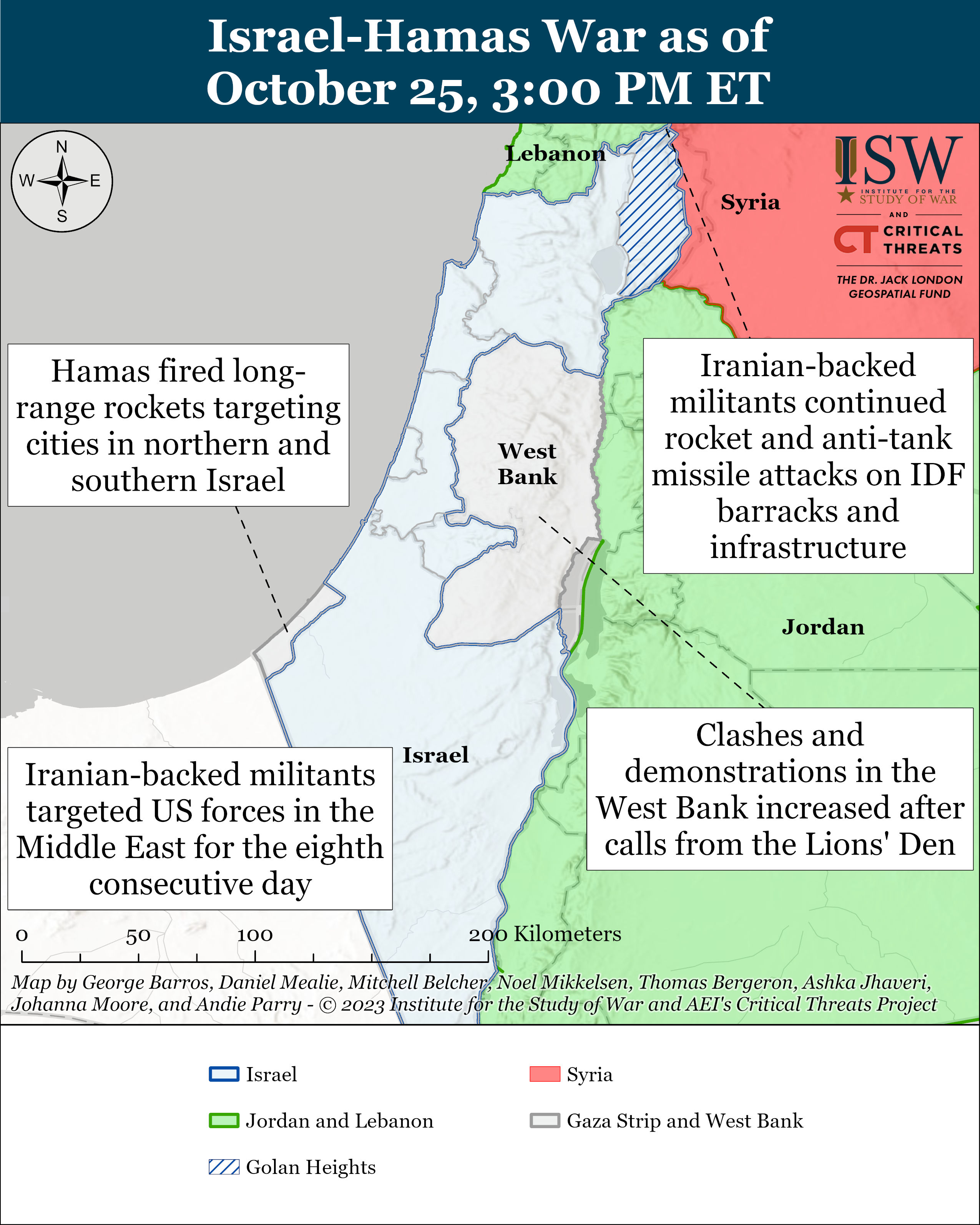
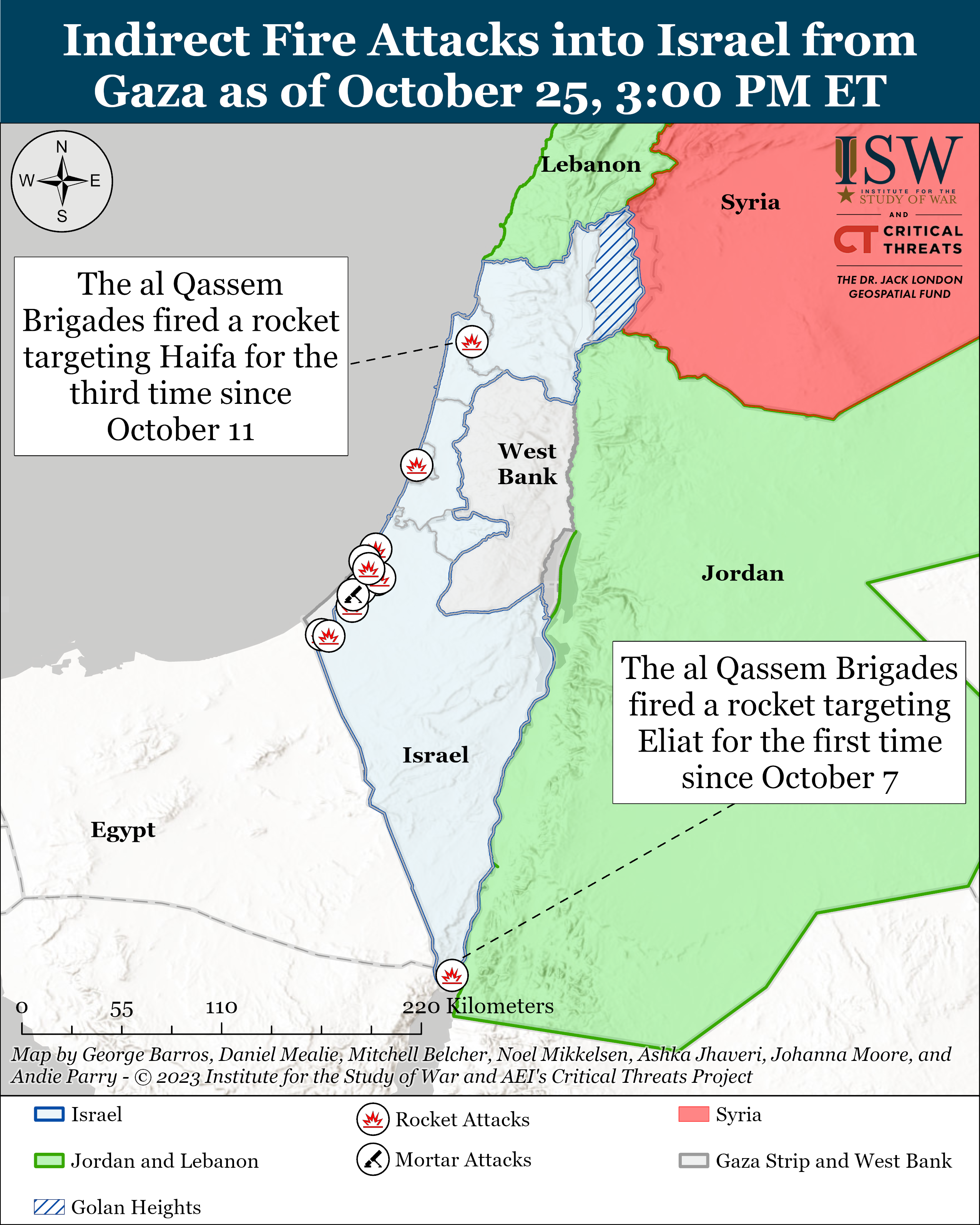
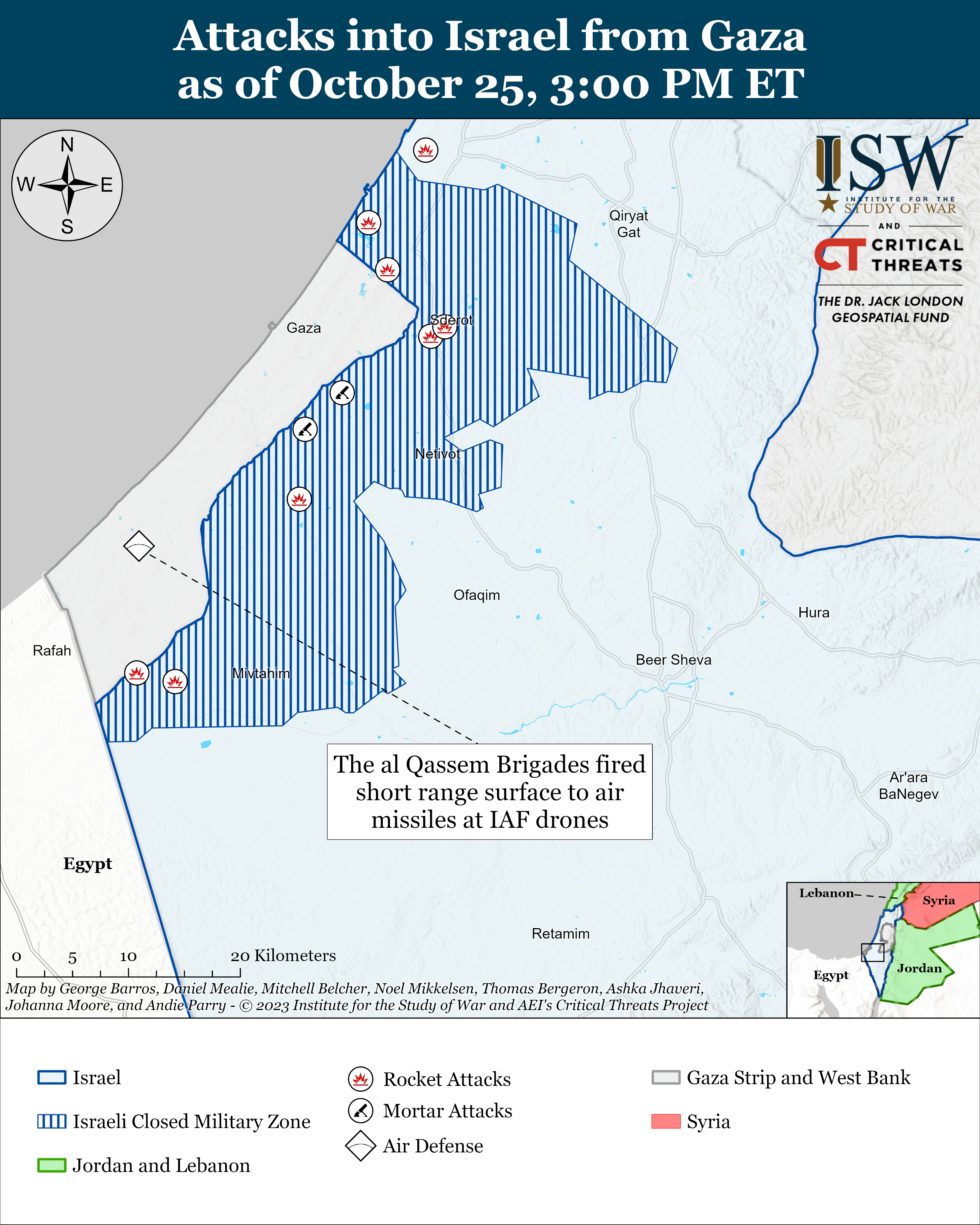
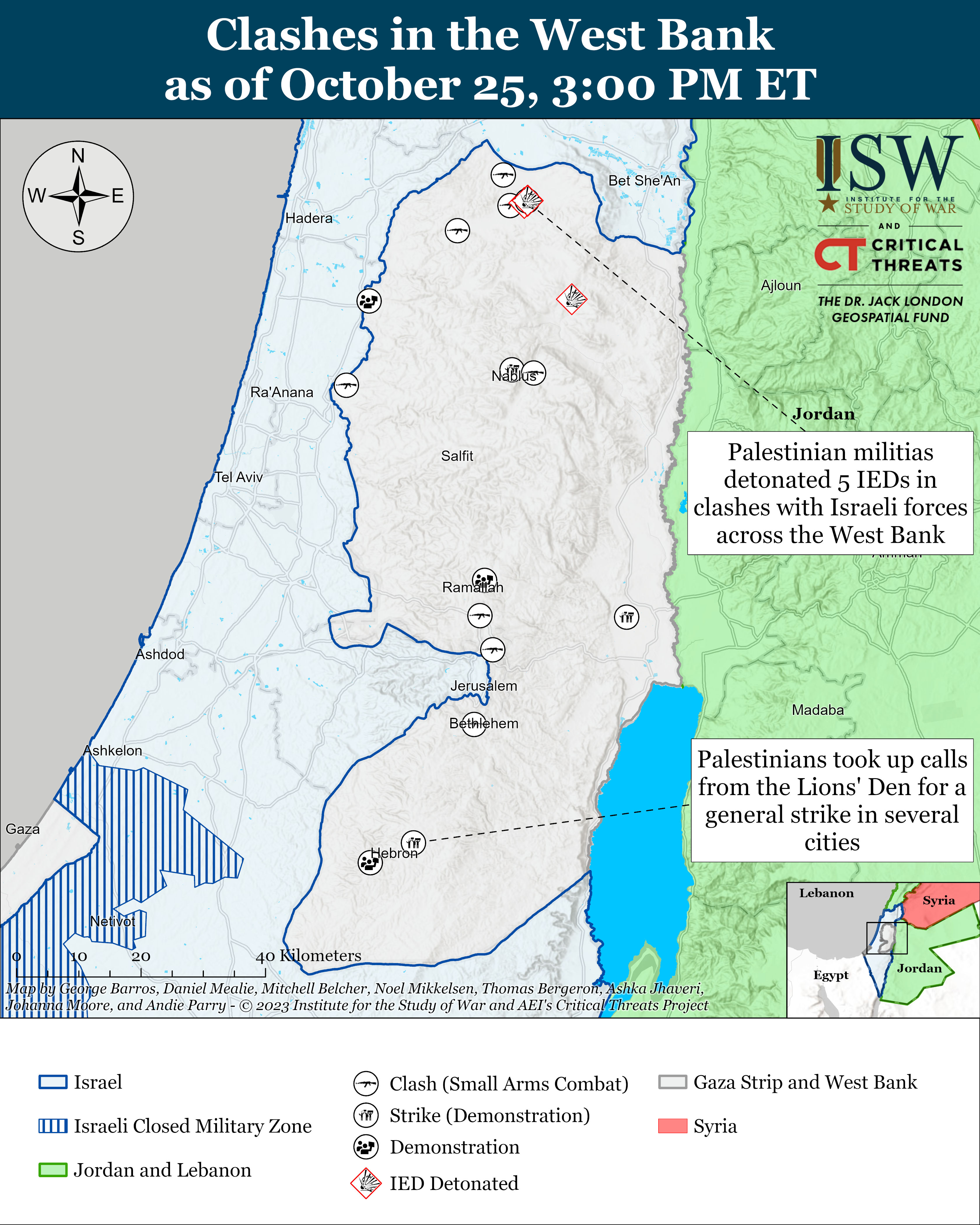
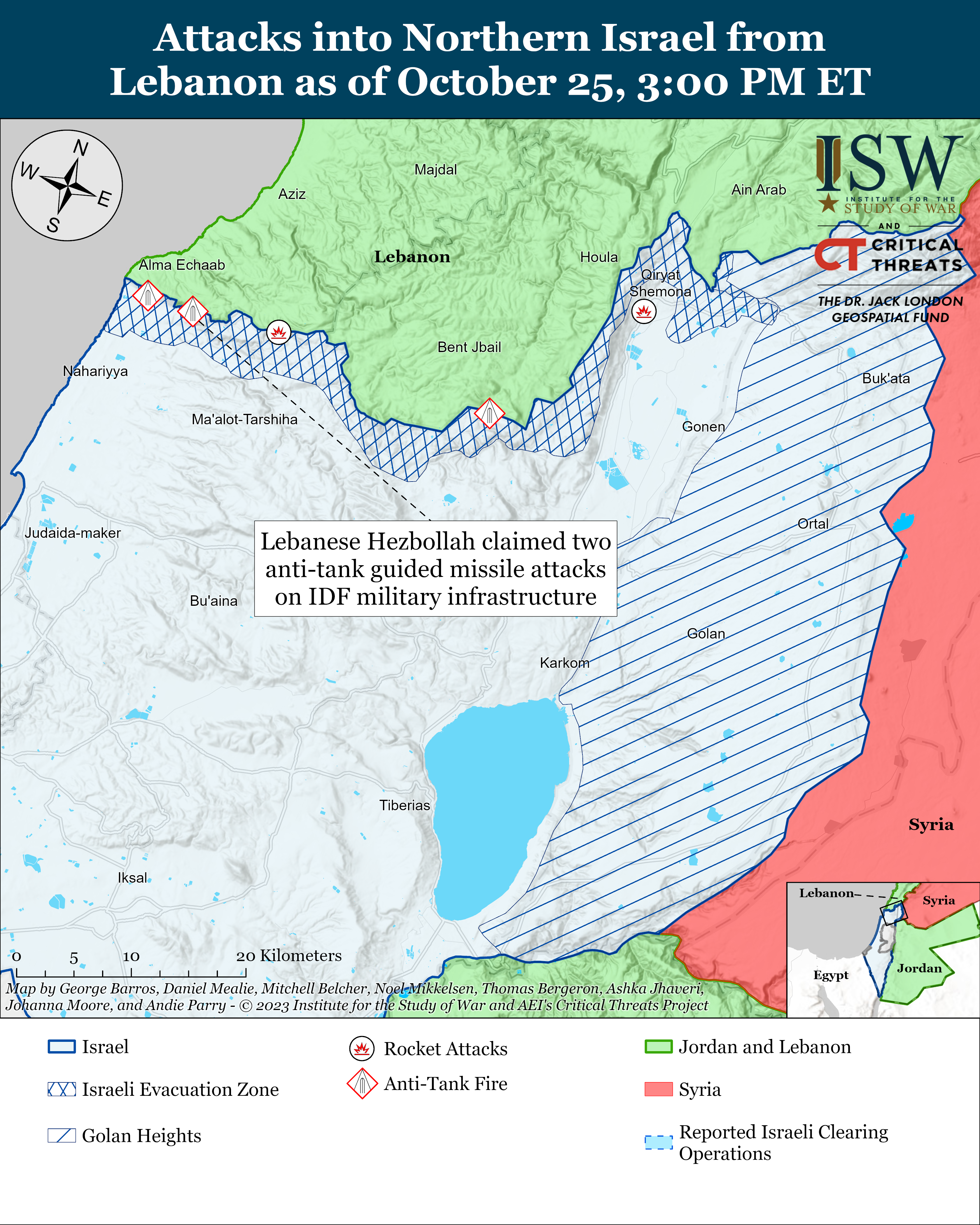
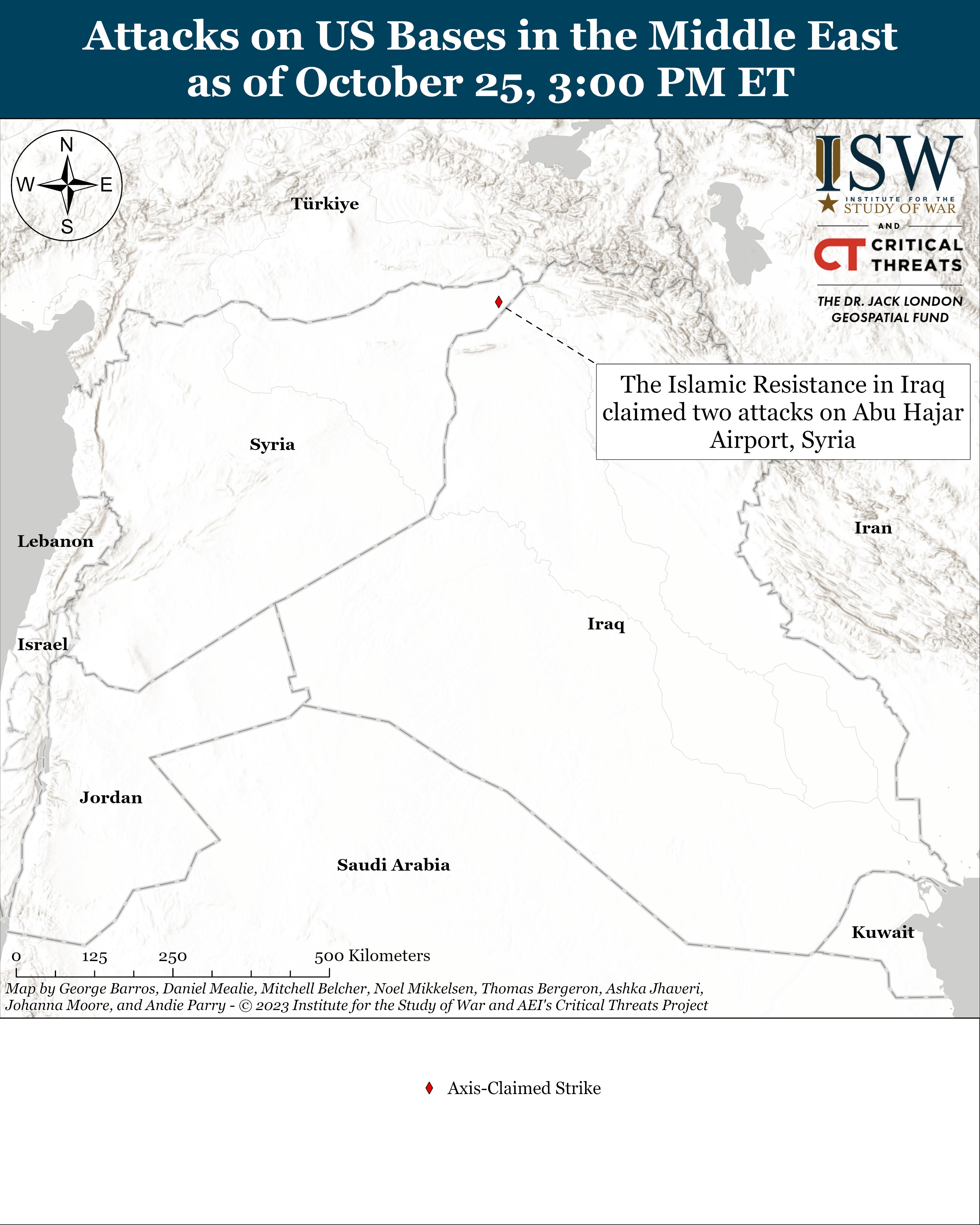
No comments:
Post a Comment